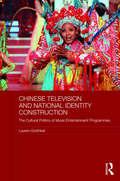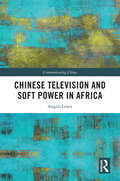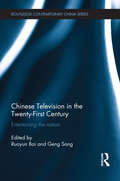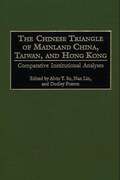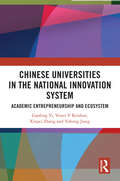- Table View
- List View
Chinese Television and National Identity Construction: The Cultural Politics of Music-Entertainment Programmes (Media, Culture and Social Change in Asia)
by Lauren GorfinkelThis book examines music entertainment programmes on China Central Television, China’s only national level television network, as well as on nationally-available provincial channels, exploring how such programmes project a nuanced image of China’s identity and position in the world. It shows how the images presented - primarily to domestic audiences - are in step with China’s party-state nationalism, and at the same time flexible and open to change as China’s circumstances change. The book contextualises identity construction in the media by examining the development of television in China and the political struggles between provincial and national television stations, as well as by foregrounding the historical and contemporary role of musical culture in China's nation-building project. It discusses the portrayal of the majority Han Chinese, and of ethnic minorities and their music, which, the author argues, are shown as fitting with the party-state rhetoric of “a unitary multi-ethnic state”. It also outlines how the Chinese of Greater China – Hong Kong, Taiwan, Macao and the overseas Chinese – are incorporated into a mainland centred Chinese identity. In addition, it shows how the performances of foreign personalities on the Chinese television stage emphasise foreigners' attraction to China, the uniqueness of the Chinese nation and Chinese civilisation, and the revitalised role of China in the world. Overall, the book demonstrates how the variations of Chinese identity fit with prevailing political ideologies in China and with the emerging theme of a China-centred world.
Chinese Television and National Identity Construction: The Cultural Politics of Music-Entertainment Programmes (Media, Culture and Social Change in Asia)
by Lauren GorfinkelThis book examines music entertainment programmes on China Central Television, China’s only national level television network, as well as on nationally-available provincial channels, exploring how such programmes project a nuanced image of China’s identity and position in the world. It shows how the images presented - primarily to domestic audiences - are in step with China’s party-state nationalism, and at the same time flexible and open to change as China’s circumstances change. The book contextualises identity construction in the media by examining the development of television in China and the political struggles between provincial and national television stations, as well as by foregrounding the historical and contemporary role of musical culture in China's nation-building project. It discusses the portrayal of the majority Han Chinese, and of ethnic minorities and their music, which, the author argues, are shown as fitting with the party-state rhetoric of “a unitary multi-ethnic state”. It also outlines how the Chinese of Greater China – Hong Kong, Taiwan, Macao and the overseas Chinese – are incorporated into a mainland centred Chinese identity. In addition, it shows how the performances of foreign personalities on the Chinese television stage emphasise foreigners' attraction to China, the uniqueness of the Chinese nation and Chinese civilisation, and the revitalised role of China in the world. Overall, the book demonstrates how the variations of Chinese identity fit with prevailing political ideologies in China and with the emerging theme of a China-centred world.
Chinese Television and Soft Power in Africa (Communicating China)
by Angela LewisThis book examines the phenomenal growth over recent years of Star Times, a Chinese pay television company with around 30 million subscribers providing satellite television to twenty African countries. The broadcaster, whose markets include demographic groups deemed uneconomic by Western television providers, combines entertainment such as Chinese drama and kung fu content dubbed into African languages with Chinese state programming, thus making the station at least partially a public diplomacy instrument. At the same time, the channel provides new indigenous language channels, widened access to television in rural areas, and sponsors African soccer brands. The book considers all aspect of Star Times: how it fits into China’s development assistance programmes; its structure as a private company nonetheless financed by Chinese banks; and, based on extensive interview research in Ghana, Kenya and Zambia, how the station is perceived by media professionals. Overall, the book shows how this major Chinese international media expansion both contributes very significantly to African development in a way which is sensitive to local concerns, and at the same time enhances China’s international image.
Chinese Television and Soft Power in Africa (Communicating China)
by Angela LewisThis book examines the phenomenal growth over recent years of Star Times, a Chinese pay television company with around 30 million subscribers providing satellite television to twenty African countries. The broadcaster, whose markets include demographic groups deemed uneconomic by Western television providers, combines entertainment such as Chinese drama and kung fu content dubbed into African languages with Chinese state programming, thus making the station at least partially a public diplomacy instrument. At the same time, the channel provides new indigenous language channels, widened access to television in rural areas, and sponsors African soccer brands. The book considers all aspect of Star Times: how it fits into China’s development assistance programmes; its structure as a private company nonetheless financed by Chinese banks; and, based on extensive interview research in Ghana, Kenya and Zambia, how the station is perceived by media professionals. Overall, the book shows how this major Chinese international media expansion both contributes very significantly to African development in a way which is sensitive to local concerns, and at the same time enhances China’s international image.
Chinese Television in the Twenty-First Century: Entertaining the Nation (Routledge Contemporary China Series)
by Ruoyun Bai Geng SongThe past two decades witnessed the rise of television entertainment in China. Although television networks are still state-owned and Party-controlled in China, the ideological landscape of television programs has become increasingly diverse and even paradoxical, simultaneously subservient and defiant, nationalistic and cosmopolitan, moralistic and fun-loving, extravagant and mundane. Studying Chinese television as a key node in the network of power relationships, therefore, provides us with a unique opportunity to understand the tension-fraught and , paradox-permeated conditions of Chinese post-socialism. This book argues for a serious engagement with television entertainment. rethinking, It addresses the following questions. How is entertainment television politically and culturally significant in the Chinese context? How have political, industrial, and technological changes in the 2000s affected the way Chinese television relates to the state and society? How can we think of media regulation and censorship without perpetuating the myth of a self-serving authoritarian regime vs. a subdued cultural workforce? What do popular televisual texts tell us about the unsettled and reconfigured relations between commercial television and the state? The book presents a number of studies of popular television programs that are sensitive to the changing production and regulatory contexts for Chinese television in the twenty-first century. As an interdisciplinary study of the television industry, this book covers a number of important issues in China today, such as censorship, nationalism, consumerism, social justice, and the central and local authorities. As such, it will appeal to a broad audience including students and scholars of Chinese culture and society, media studies, television studies, and cultural studies.
Chinese Television in the Twenty-First Century: Entertaining the Nation (Routledge Contemporary China Series)
by Ruoyun Bai Geng SongThe past two decades witnessed the rise of television entertainment in China. Although television networks are still state-owned and Party-controlled in China, the ideological landscape of television programs has become increasingly diverse and even paradoxical, simultaneously subservient and defiant, nationalistic and cosmopolitan, moralistic and fun-loving, extravagant and mundane. Studying Chinese television as a key node in the network of power relationships, therefore, provides us with a unique opportunity to understand the tension-fraught and , paradox-permeated conditions of Chinese post-socialism. This book argues for a serious engagement with television entertainment. rethinking, It addresses the following questions. How is entertainment television politically and culturally significant in the Chinese context? How have political, industrial, and technological changes in the 2000s affected the way Chinese television relates to the state and society? How can we think of media regulation and censorship without perpetuating the myth of a self-serving authoritarian regime vs. a subdued cultural workforce? What do popular televisual texts tell us about the unsettled and reconfigured relations between commercial television and the state? The book presents a number of studies of popular television programs that are sensitive to the changing production and regulatory contexts for Chinese television in the twenty-first century. As an interdisciplinary study of the television industry, this book covers a number of important issues in China today, such as censorship, nationalism, consumerism, social justice, and the central and local authorities. As such, it will appeal to a broad audience including students and scholars of Chinese culture and society, media studies, television studies, and cultural studies.
Chinese Theology and Translation: The Christianity of the Jesuit Figurists and their Christianized Yijing
by Sophie Ling-chia WeiThis book uncovers the Jesuits’ mystic theological interpretation in the translation of the Book of Changes (the Yijing) in their mission in China. The book analyzes how Jesuit Figurists incorporated their intralingual translation of the Yijing, the Classical and vernacular use of Chinese language and the imitation of Chinese literati’s format, and the divinization of Yijing numbers into their typological exegesis. By presenting the different ways in which Jesuit Figurists Christianized the Yijing and crafted a Chinese version of Jesus and Christian stories onto the Chinese classics, this book reveals the value of Jesuit missionary-translators. The Chinese manuscripts the Figurists left behind became treasures which have been excavated and displayed in this book. These treasures reveal the other side of the story, the side not much shown in past scholarship on the Figurists. These handwritten manuscripts on the Christianized Yijing are a legacy which continues to impact European understanding of Chinese history and civilization in later centuries. A first analysis of these manuscripts in Chinese, the book will be of interest to scholars working on the history of Christianity in China, Translation Studies, and East Asian Religion and Philosophy.
Chinese Theology and Translation: The Christianity of the Jesuit Figurists and their Christianized Yijing
by Sophie Ling-chia WeiThis book uncovers the Jesuits’ mystic theological interpretation in the translation of the Book of Changes (the Yijing) in their mission in China. The book analyzes how Jesuit Figurists incorporated their intralingual translation of the Yijing, the Classical and vernacular use of Chinese language and the imitation of Chinese literati’s format, and the divinization of Yijing numbers into their typological exegesis. By presenting the different ways in which Jesuit Figurists Christianized the Yijing and crafted a Chinese version of Jesus and Christian stories onto the Chinese classics, this book reveals the value of Jesuit missionary-translators. The Chinese manuscripts the Figurists left behind became treasures which have been excavated and displayed in this book. These treasures reveal the other side of the story, the side not much shown in past scholarship on the Figurists. These handwritten manuscripts on the Christianized Yijing are a legacy which continues to impact European understanding of Chinese history and civilization in later centuries. A first analysis of these manuscripts in Chinese, the book will be of interest to scholars working on the history of Christianity in China, Translation Studies, and East Asian Religion and Philosophy.
Chinese Thought: From Confucius to Cook Ding (Pelican Books)
by Roel SterckxShortlisted for the PEN Hessel-Tiltman Prize'A terrific book, rich and endlessly thought provoking. . . If you are looking for one book to understand the core ideas of Chinese civilisation, read this' - Michael WoodAn engrossing history of ancient Chinese philosophy and culture from an eminent Cambridge expertWe are often told that the twenty-first century is bound to become China's century. Never before has Chinese culture been so physically, digitally, economically or aesthetically present in everyday Western life. But how much do we really know about its origins and key beliefs? How did the ancient Chinese think about the world?In this enlightening book, Roel Sterckx, one of the foremost experts in Chinese thought, takes us through centuries of Chinese history, from Confucius to Daoism to the Legalists. The great questions that have occupied China's brightest minds were not about who and what we are, but rather how we should live our lives, how we should organise society and how we can secure the well-being of those who live with us and for whom we carry responsibility.With evocative examples from philosophy, literature and everyday life, Sterckx shows us how the ancient Chinese have shaped the thinking of a civilization that is now influencing our own.
Chinese Traditional Theatre and Male Dan: Social Power, Cultural Change and Gender Relations (Routledge Advances in Theatre & Performance Studies)
by Guo ChaoThis book examines male dan, a male actor who performs female roles in Chinese theatre. Through the rise, fall and tenuous survival of male dan in Chinese history, Guo Chao reflects the transformations in the social zeitgeist in China, especially the politics of gender and sexuality. The breadth of this study reflects a diversified set of sources, ranging from classical to contemporary texts (texts of jingju plays, memoirs, collections of notation books) and other commentaries and critical evaluations of dan actors (in both English and Chinese languages), to video and audio materials, films, and personal interviews. This book will be of great interest to students and scholars of East Asian/Chinese studies across the fields of theatre, history, culture, and literature.
Chinese Traditional Theatre and Male Dan: Social Power, Cultural Change and Gender Relations (Routledge Advances in Theatre & Performance Studies)
by Guo ChaoThis book examines male dan, a male actor who performs female roles in Chinese theatre. Through the rise, fall and tenuous survival of male dan in Chinese history, Guo Chao reflects the transformations in the social zeitgeist in China, especially the politics of gender and sexuality. The breadth of this study reflects a diversified set of sources, ranging from classical to contemporary texts (texts of jingju plays, memoirs, collections of notation books) and other commentaries and critical evaluations of dan actors (in both English and Chinese languages), to video and audio materials, films, and personal interviews. This book will be of great interest to students and scholars of East Asian/Chinese studies across the fields of theatre, history, culture, and literature.
Chinese Transnational Migration in the Age of Global Modernity: The Case of Oceania (Routledge Studies in Asian Diasporas, Migrations and Mobilities)
by Liangni Sally LiuThe term ‘circulatory transnational migration’ best describes the unconventional migratory route of many contemporary Chinese migrants – that is an unfinished set of circulatory movements that these migrants engage in between the homeland and various host countries. ‘Return migration’, ‘step migration’ to a third destination and the ‘astronauting’ strategy are all included within this circulatory migration movement wherein ‘returning’ to the country of origin does not always mean to settle back to the homeland permanently; while ‘step migration’ also does not necessarily mean to re-migrate to a third destination country for a permanent purpose. Liu takes a longitudinal perspective to study Chinese migrants’ transnational movements and looks at their transnational migratory movements as a family matter and progressive and dynamic process, using New Zealand as a primary case study. She examines Chinese migrants’ initial motives for immigrating to New Zealand; the driving forces behind their adoption of a transnational lifestyle which includes leaving New Zealand to return to China, moving to a third country – typically Australia - or commuting across borders; family-related considerations; inter-generational dynamics in transnational migration; as well as their future movement intentions. Liu also discusses Chinese migrants’ conceptualisation of ‘home’, citizenship, identity, and sense of belonging to provide a deeper understanding of their transnational migratory experiences.
Chinese Transnational Migration in the Age of Global Modernity: The Case of Oceania (Routledge Studies in Asian Diasporas, Migrations and Mobilities)
by Liangni Sally LiuThe term ‘circulatory transnational migration’ best describes the unconventional migratory route of many contemporary Chinese migrants – that is an unfinished set of circulatory movements that these migrants engage in between the homeland and various host countries. ‘Return migration’, ‘step migration’ to a third destination and the ‘astronauting’ strategy are all included within this circulatory migration movement wherein ‘returning’ to the country of origin does not always mean to settle back to the homeland permanently; while ‘step migration’ also does not necessarily mean to re-migrate to a third destination country for a permanent purpose. Liu takes a longitudinal perspective to study Chinese migrants’ transnational movements and looks at their transnational migratory movements as a family matter and progressive and dynamic process, using New Zealand as a primary case study. She examines Chinese migrants’ initial motives for immigrating to New Zealand; the driving forces behind their adoption of a transnational lifestyle which includes leaving New Zealand to return to China, moving to a third country – typically Australia - or commuting across borders; family-related considerations; inter-generational dynamics in transnational migration; as well as their future movement intentions. Liu also discusses Chinese migrants’ conceptualisation of ‘home’, citizenship, identity, and sense of belonging to provide a deeper understanding of their transnational migratory experiences.
The Chinese Triangle of Mainland China, Taiwan, and Hong Kong: Comparative Institutional Analyses (Controversies in Science)
by Alvin Y. So Nan Lin Dudley PostonThe Chinese triangle of mainland China, Hong Kong, and Taiwan constitutes one of the most dynamic regions in the world economy. Since the late 1970s, these three societies have experienced increasing economic integration; however, studies aimed at analyzing and explaining this integration have often overlooked the very important role social institutions have played in the shaping of this process. To fill this gap, this book adopts a systematic institutional approach designed to examine the different patterns of institutions in the three countries and to discuss how such social institutions as the economy, gender, social networks, and the Chinese diaspora have exerted a profound impact on all three societies. The chapters, taken together, argue that different patterns of institutional configuration have led to divergent paths of development, and that this divergence will have significant implications on the prospects for Chinese national reunification in the twenty-first century.The Introductory chapter provides a historical discussion on the origins and the transformation of the Chinese triangle during the second half of the twentieth century. The remainder of the volume is broken into four topics considered crucial for understanding the transformation of the Chinese triangle: economic transformation, gender, social networks, and the Chinese diaspora. As globalization impacts the Chinese triangle, studies that consider the issues from the perspective of social institutions will be increasingly important to understanding the area as it develops in the world economy.
Chinese Universities in the National Innovation System: Academic Entrepreneurship and Ecosystem
by Yi Gaofeng Venni V. Krishna Xinpei Zhang Yuheng JiangThis book closely examines how universities and higher educational institutions have come to occupy a very significant position in the Chinese national Iinnovation system (NIS) in the last two decades. It looks at the growth, structure and current status of higher education in China and discusses how these world-class institutions are intimately intertwined with the rise of China in the global knowledge economy. It studies themes such as the impact of Chinese universities on industry, business enterprises and national development, relevance of higher education to policies related to industry development, reform measures to improve research intensity and quality of teaching, and internationalization and globalization of higher education. Based on sound empirical research, it also explores concepts like academic entrepreneurship, start-ups and entrepreneurial ecosystems. A key text on the Chinese education sector, the book will be of interest to scholars and researchers of higher education, Chinese studies, science, technology and innovation studies, business economics and management, academic entrepreneurship and public policy.
Chinese Universities in the National Innovation System: Academic Entrepreneurship and Ecosystem
by Yi Gaofeng Venni V. Krishna Xinpei Zhang Yuheng JiangThis book closely examines how universities and higher educational institutions have come to occupy a very significant position in the Chinese national Iinnovation system (NIS) in the last two decades. It looks at the growth, structure and current status of higher education in China and discusses how these world-class institutions are intimately intertwined with the rise of China in the global knowledge economy. It studies themes such as the impact of Chinese universities on industry, business enterprises and national development, relevance of higher education to policies related to industry development, reform measures to improve research intensity and quality of teaching, and internationalization and globalization of higher education. Based on sound empirical research, it also explores concepts like academic entrepreneurship, start-ups and entrepreneurial ecosystems. A key text on the Chinese education sector, the book will be of interest to scholars and researchers of higher education, Chinese studies, science, technology and innovation studies, business economics and management, academic entrepreneurship and public policy.
Chinese Urban Reform: What Model Now?
by Kwok Yin-WangBased on a 1987 conference on urban development at the Centre for Urban Planning and Development at Hong Kong University.
Chinese Urban Reform: What Model Now?
by Kwok Yin-WangBased on a 1987 conference on urban development at the Centre for Urban Planning and Development at Hong Kong University.
Chinese Urban Shi-nema: Cinematicity, Society and Millennial China
by David H. Fleming Simon HarrisonThis book dives into the mise-en-scène of contemporary China to explore the “becoming cinema” of Chinese cities, societies, and subjectivities. Set in the wake of China’s radical and rapid period of urbanization and infrastructural transformation, and situating itself in the processual city of Ningbo, the book combines empirical, ficto-critical, and philosophical methods to generate a dynamic account of everyday life as new forms of consumer culture bed in. Harnessing a Realist approach that allows for different scales of analysis, the book zooms in on five architectural assemblages including: surreal real estate showrooms; a fragmented history museum; China’s “first and best” Sino-foreign university; a new “Old town”; and weird gamified “any-now(here)-spaces.” Together these modern arrangements and machines for living cast light upon the broader picture sweeping up greater China.
Chinese Urbanism: Critical Perspectives
by Mark JayneThis book provides a definitive overview of contemporary developments in our understanding of urban life in China. Multidisciplinary perspectives outline the most significant critical, theoretical, methodological and empirical developments in our appreciation of Chinese cities in the context of an increasingly globalized world. Each chapter includes reviews and appraisals of past and current theoretical development and embarks on innovative theoretical directions relating to Marxist, feminist, post-structural, post-colonial and ‘more-than-representational’ thinking. The book provides an in-depth insight into urban change and considers in what ways theoretical engagement with Chinese cities contributes to our understanding of ‘global urbanism’. Chapters explore how new critical perspectives on economic, political, social, spatial, emotional, embodied and affective practices add value to our understanding of urban life in, and beyond, China. Chinese Urbanism offers valuable insights which will be of interest to students and scholars alike working in geography, urban studies, Asian studies, economics, political studies and beyond.
Chinese Urbanism: Critical Perspectives
by Mark JayneThis book provides a definitive overview of contemporary developments in our understanding of urban life in China. Multidisciplinary perspectives outline the most significant critical, theoretical, methodological and empirical developments in our appreciation of Chinese cities in the context of an increasingly globalized world. Each chapter includes reviews and appraisals of past and current theoretical development and embarks on innovative theoretical directions relating to Marxist, feminist, post-structural, post-colonial and ‘more-than-representational’ thinking. The book provides an in-depth insight into urban change and considers in what ways theoretical engagement with Chinese cities contributes to our understanding of ‘global urbanism’. Chapters explore how new critical perspectives on economic, political, social, spatial, emotional, embodied and affective practices add value to our understanding of urban life in, and beyond, China. Chinese Urbanism offers valuable insights which will be of interest to students and scholars alike working in geography, urban studies, Asian studies, economics, political studies and beyond.
The Chinese Video Game Industry (Palgrave Games in Context)
by Feng Chen Judd Ethan Ruggill Ken S. McAllisterThe recent and dramatic development of China’s economy and international political muscle is especially pronounced in the country’s video game industry. Now the largest of its kind in the world by gross revenue, the Chinese video game industry impacts every player in the global game market and has begun to directly influence the nature of the video game medium itself. From its conceptualization of the player as a category and commodity, to its approach to the design, development, and marketing of products and services, the Chinese game industry is engaging in a complex, innovative, and fascinating reimagining of the video game as a cultural and industrial force.The purpose of The Chinese Video Game Industry is to help introduce and investigate this industrial and cultural powerhouse. The book’s contributors array the industry across its history, economics, organization, politics, and cultures, documenting its rise, exploring its operational, cultural, and aesthetic characteristics, and capturing its context vis-à-vis the global media landscape. In so doing, the contributors provide a robust resource for anyone interested in studying, building, or even simply appreciating games.
Chinese War Correspondents: Covering Wars and Conflicts in the Twenty-First Century (Palgrave Series in Asia and Pacific Studies)
by Shixin Ivy ZhangThis book engages with the Chinese mediation of wars and conflicts in the global environment.Proposing a new cascading media and conflict model, it applies this to the studyof war correspondents from six levels: media-policy relations, journalistic objectivity, roleperceptions, news framing and peace/war journalism, news practices, and audience.Based on interviews with 23 Chinese journalists and case study analysis of the Libyan War,Syrian War, Afghanistan War and Israeli-Palestinian conflict, the book demonstrates thata new breed of Chinese war correspondents has emerged today. They undergo a complexand nuanced mediated communication process. Neither traditionally Chinese in theirapproach nor western in their perceptions, they are uniquely pragmatic in negotiating theirroles in a complex web of internal and external actors and factors. The core ideology seemsto be anti-West in defiance of the US hegemony and the bias of global media as well asneutral-Muslims.Exploring the role perceptions, values, norms and practices of contemporary Chinese warcorrespondents who go outside China to bring the ‘distant culture’ back home, this text is keyreading for scholars and students in international journalism, international communication,war and peace studies, international relations and Chinese studies.
Chinese Warfighting: The PLA Experience since 1949
by Mark A. Ryan David M. Finkelstein Michael A. McDevitt CNA CorporationThis is the first systematic study of modern China's military campaigns and the actual fighting conducted by the People's Liberation Army since the founding of the People's Republic. It provides a general overview of the evolution of PLA military doctrine, and then focuses on major combat episodes from the civil war with the Nationalists to the last significant combat in Vietnam in 1979, in addition to navy and air operations through 1999. In contrast to the many works on the specifics and hardware of China's military modernization, this book discusses such topics as military planning, command, and control; fighting and politics; combat tactics and performance; technological catch-up and doctrinal flexibility; the role of Mao Zedong; scale and typologies of fighting; and deterrence. The contributors include scholars from Mainland China, Taiwan, and the United States, who draw from a wealth of fresh archival sources.
Chinese Warfighting: The PLA Experience since 1949
by Mark A. Ryan David M. Finkelstein Michael A. McDevitt CNA CorporationThis is the first systematic study of modern China's military campaigns and the actual fighting conducted by the People's Liberation Army since the founding of the People's Republic. It provides a general overview of the evolution of PLA military doctrine, and then focuses on major combat episodes from the civil war with the Nationalists to the last significant combat in Vietnam in 1979, in addition to navy and air operations through 1999. In contrast to the many works on the specifics and hardware of China's military modernization, this book discusses such topics as military planning, command, and control; fighting and politics; combat tactics and performance; technological catch-up and doctrinal flexibility; the role of Mao Zedong; scale and typologies of fighting; and deterrence. The contributors include scholars from Mainland China, Taiwan, and the United States, who draw from a wealth of fresh archival sources.
